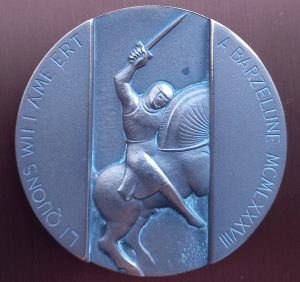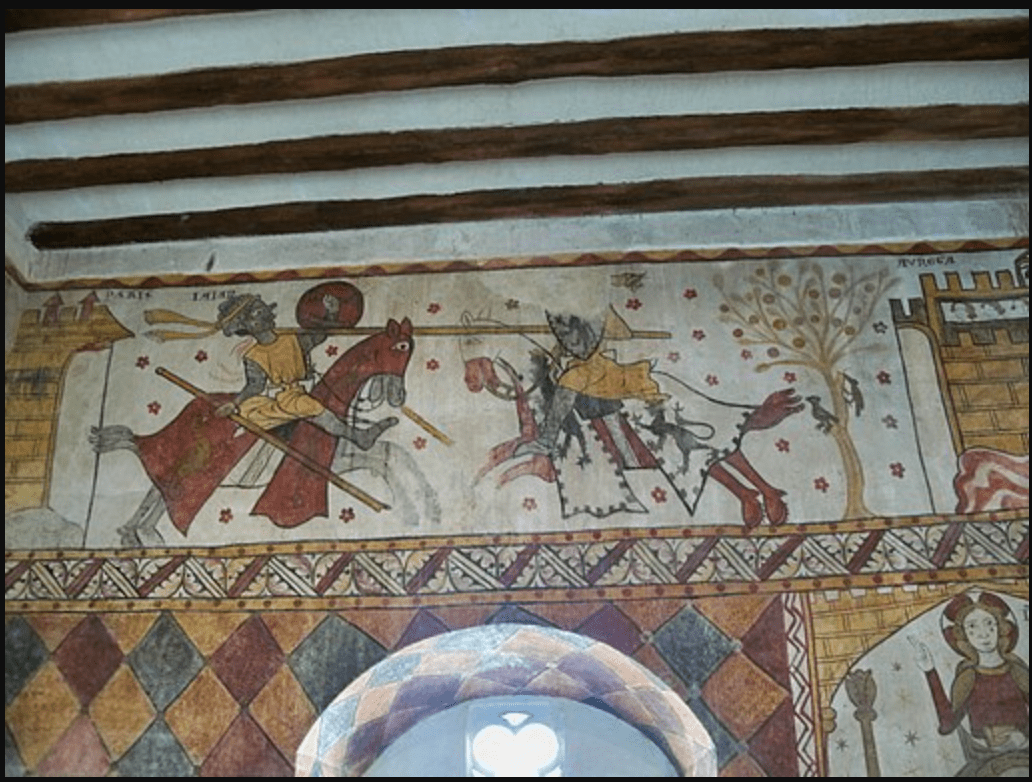France
extant poem compiled in parts between c. 1130 and 1175/80
Anonymous
La Chanson de Guillaume
Although known only through one complete manuscript and two fragments, all thirteenth-century Anglo-Norman, La Chanson de Guillaume originated in continental France. Its earliest sections—possibly dating from the late-tenth or eleventh century, although the extant first part of the poem was probably composed about 1130 CE—show the influence of writings by St Bernard of Clairvaux on the military Order of the Temple.
The poem’s complete version, the London manuscript, has links to other poems of the Cycle of Guillaume d’Orange (the collected poems dealing with Guillaume and various of his legendary relatives), notably the Chevalerie Vivien and Aliscans, while the late thirteenth-century fragments align the poem with another cyclic chanson: Foulque de Candie. However, La Chanson de Guillaume never found its place within a cyclic manuscript.
The probable historical prototype of the epic hero was a nephew of the emperor Charlemagne, who appointed him Count of Toulouse and military advisor to his son Louis, the future emperor Louis the Pious, then the youthful King of Aquitaine. Defeated by an invading Moorish army on the river Orbieu in southwest France in 793, Guillaume commanded the army that Louis led across the Pyrenees to capture Barcelona in 801. All his military activity was in southwest France: he never had connections to Orange or the Rhône valley. In 804 he retired to a monastery, settling first in Aniane, before founding his own house at Gellone (known today as Saint-Guilhem-le-Désert, in the Hérault department in the Occitania region). While the first part of La Chanson de Guillaume places the hero correctly in southwest France and Barcelona, the second part bears witness to his transposition to the Rhône valley, to Orange and Arles, site of the Roman necropolis of “Les Aliscans.” The closing poem of the cycle, Le Moniage Guillaume (Guillaume’s Life as a Monk), returns to a highly fictionalized account of the historical Guillaume’s final years.
The poem opens in Bourges, where Tedbalt, count of Bourges, has gathered with his own nephew Esturmi and Guillaume’s nephew Vivien, who has brought his warband of 700 knights. A messenger announces the defeat of a Frankish army by the invading pagan king Desramed of Cordoba. Tedbalt and Esturmi boast drunkenly of defeating the invaders, while Vivien remains sober and advises sending to Guillaume for support. The next day, confronted by the reality of the pagan army, Tedbalt and Esturmi prove cowards and flee, leaving Vivien, his cousin Girart, and their small army to face the enemy. The site of the battle is “Larchamp,” a name which has been variously interpreted, but which in the poem is a desert-like wasteland close to the sea. This part of the song (lines 1-695) dwells on the horrors of war with the bloody slaughter of Vivien’s army. When the army is reduced to just a few surviving warriors, Vivien sends Girart with messages to Guillaume, asking for aid and reminding him of services rendered, to Guibourc, Guillaume’s wife, reminding her of how she brought him up and asking her to send her husband to save him, and to another young cousin, Gui, technically not old enough to be a warrior but who must now strap on a sword and come to Vivien’s aid. Girart departs on his mission, abandoning his arms and armour along the way as too hot and heavy to bear; he finally arrives in “Barzelune” (probably Barcelona), where he can deliver his messages. Meanwhile, at Larchamp, Vivien, sole survivor of the Frankish army, offers prayers to God similar to Christ’s Gethsemane prayers in the Bible, praying that he may not flee to avoid his fate. He is finally slaughtered by a group of pagans, his body taken and thrown in a ditch so that Christians cannot find it. With Girart’s arrival at Barcelona (line 932) the first and oldest part of the poem ends.
The second part of the song (lines 933-1228) is probably an Anglo-Norman interpolation. Guischart, originally the young hero of the second part of the poem, a role still visible in the St Andrews fragments, is now a nephew of Guibourc rather than of Guillaume. The idyllic scene between Guillaume and his wife on the walls of Barcelona which opens the section (938-55) is interrupted by the arrival of Girart with disastrous news from Larchamp. We learn that Guillaume has already lost one army in a battle near Toulouse and that Guibourc is a converted Saracen. Guischart converted with her, but will revert to his pagan faith on receiving a mortal wound in the second battle of Larchamp (he replaces Gui in this part of the song). As the emperor Louis will do later, Guillaume protests that he cannot go to rescue Vivien because he has lost an army and is exhausted. The narrator states, however, that he does this simply to test his wife’s mettle. The next day Guillaume departs for Larchamp with an army of 30,000 men, although there is no indication how the force was raised. When Guillaume and his army arrive, the Saracens are waiting for a fair wind to depart with the booty taken from Vivien’s defeated warriors. Their 100,000 strong army annihilates the Franks a second time. Girart dies heroically, while Guischart dies miserably as an apostate. Guillaume, the sole survivor of the massacre, is forced, because of an oath he had sworn to Guibourc (lines 1037-38), to carry Guischart’s body back presumably to Barcelona, although the town is not named in this part of the song. Part Two of the extant song ends with Guillaume riding away from the battlefield; with a certain sly humour the narrator assures the audience that Guillaume is not fleeing, merely “going away” (lines 1225-28).
Part Three, probably originally the second part of a diptych of defeat and revenge, opens with Guibourc, clearly prescient, raising a new army of 30,000 men from her own vassals (lines 1232-35). On entering the town Guillaume is deeply depressed, but Guibourc cheers him, tells him about the army she has raised, and offers to lie to them about the situation: Guillaume has returned with news of victory; the only function of the new force will be to gather booty from a small body of pagans stranded because their boats have been smashed. She then acts as a sovereign, telling the men that for this service Guillaume will reward them with lands, and that, if they require a wife to go with the lands, she will give them 160 maidens from her household. After a hearty meal, Guillaume leads away the army but orders Gui to stay behind because he is too young to fight. This contradicts Vivien’s message in Part One. However, Gui cajoles his aunt into arming him and lending him a pony, then rides to join the army. After another slaughter of the Frankish army, only Guillaume and Gui survive; the narrator assures us that, without the presence of Gui, Guillaume would not have returned home. Preparing the narrative of the added “Chanson de Rainouart,” the poet states that a number of Frankish nobles have been taken prisoner, including the previously killed Guischart and a “Guielin,” who may or may not be the same character as the Gui currently on the field next to Guillaume. The section ends with a duel between Guillaume and Desramed, the standard motif of a battle settled between commanders, although this one is burlesque because Guillaume, whose horse has been killed under him, is riding Gui’s pony, which he cannot get to move. He waits for the Saracen king and cuts his leg off with his sword as he passes. Gui, not satisfied to leave Desramed alive, then cuts off his head. Guillaume reproaches him for unchivalrous conduct, but Gui points out, crudely, that the Saracen still had the essential attributes or rulership: his masculinity and his sight. He and his heirs would have made trouble for Christians in the future if not dealt with at once. Guillaume approves and declares Gui to be his heir. The poet announces that Guillaume has won his battle (line 1980).
There follows in the extant complete manuscript (lines 1981-3554) what is effectively the “Chanson de Rainouart” (“Renewart” in the Anglo-Norman text). Much is changed: Guillaume has lost his battle, finds Vivien alive, gives him communion and the last rites, but still cannot carry him from the field; he returns not to Barcelona, but to Orange, already under siege, where he must prove his identity to Guibourc by single-handedly rescuing Christian prisoners being led off by a troop of pagans. After familiar scenes between the couple, Guibourc persuades Guillaume to ask the emperor Louis for his aid. This he does, meeting several kinsmen in court. When Louis finally agrees, the queen, unnamed in this version but identified as Guillaume’s sister, objects on the grounds that Guibourc is a pagan sorceress who will poison them to make Guillaume king (lines 2590-96). This refers to her role in the La Prise d’Orange, where she is a Saracen princess, wife of the pagan king Thiebaut. Guillaume berates her in the most obscene terms. As Guillaume prepares to depart with the imperial army, a large, ragged young man emerges from the kitchens where he has been put to work by Louis. He begs to be allowed to join Guillaume’s army, and Guillaume accepts him. They return to Orange, then to Larchamp, where after many burlesque encounters, all won by Renewart with his mighty club, victory is gained. It transpires that Renewart is the son of Desramed and sister of Guibourc, herself thus made daughter of the Saracen commander of the first part of the poem. Finally, Renewart is granted his long-desired baptism, a wife and lands, both in the gift of Guillaume and Guibourc.
Philip E. Bennett
University of Edinburgh
Resources
Manuscripts
London. British Library, MS Additional 38663
St Andrews, University Library, MS PQ 1463 G78 ms 228 (fragments)
Editions and Translations
La Chanson de Guillaume, edited and translated by Philip E. Bennett (London: Grant & Cutler, 2000).
La Chanson de Guillaume, Texte édité, traduit et annoté par François Suard, Lettres Gothiques, Livre de Poche, 4576 (Paris: Librairie Générale Française, 2008).
“The Song of William” in William, Count of Orange: Four Old French Epics, edited by Glanville Price with an introduction by Lynette Muir, translated by Glanville Price, Lynette Muir and David Hoggan (London: Dent; Totowa, NJ: Rowman and Littlefield, 1975).
The Song of William (La Chançun de Guillelme), translated into verse by Edward Noble Stone (Seattle: University of Washington Press, 1951).
“The Song of William” in Heroes of the French epic: a selection of chansons de geste, translated by Michael A.H. Newth (Woodbridge, UK; Rochester, NY: Boydell Press, 2005).
Critical studies
Bennett, Philip E., La Chanson de Guillaume and La Prise d’Orange (London: Grant & Cutler, 2000).
Black, Patricia Eileen, “The Couple in the Chanson de Guillaume”, PhD Dissertation, Cornell University 1985 (DAI, 46 [1985-1986] 1935).
Grunmann, Minette Helen, “Temporal Patterns in the Chanson de Guillaume”, Olifant, 4 (1976-1977), pp. 49-62.
Lejeune, Rita, “Le camouflage de détails essentiels dans la Chanson de Guillaume”, Cahiers de Civilisation Médiévale, 3 (1960), pp. 42-58
Nichols, Stephen G., Jr., “The Rhetoric of Recapitulation in the Chanson de Guillaume”, in Studies in Honor of Tatiana Fotitch, ed. Josep M. Solá-Solé et al. (Washington DC: Catholic University of America Press, 1972), pp. 79-92.
Wathelet-Willem, Jeanne, Recherches sur la Chanson de Guillaume. Études accompagnées d’une edition 2 vols (Paris: Les Belles Lettres, 1975).
Williamson, Joan B., “Structural Unity in the Chanson de Guillaume: the Role of Rainouart, South Atlantic Revue, 52 (1987) pp. 15-24.
The above bibliography was supplied by Philip E. Bennett, University of Edinburgh.
Coffret with the Legend of Guilhem, count of Toulouse, ca. 1200–1225, Met Museum, New York.
Le chemin de Saint Guilhem. Songs of William. This site discusses Guillaume d’Orange’s legendary career according to the cycle of epics devoted to him. It features several images, including the one below:


